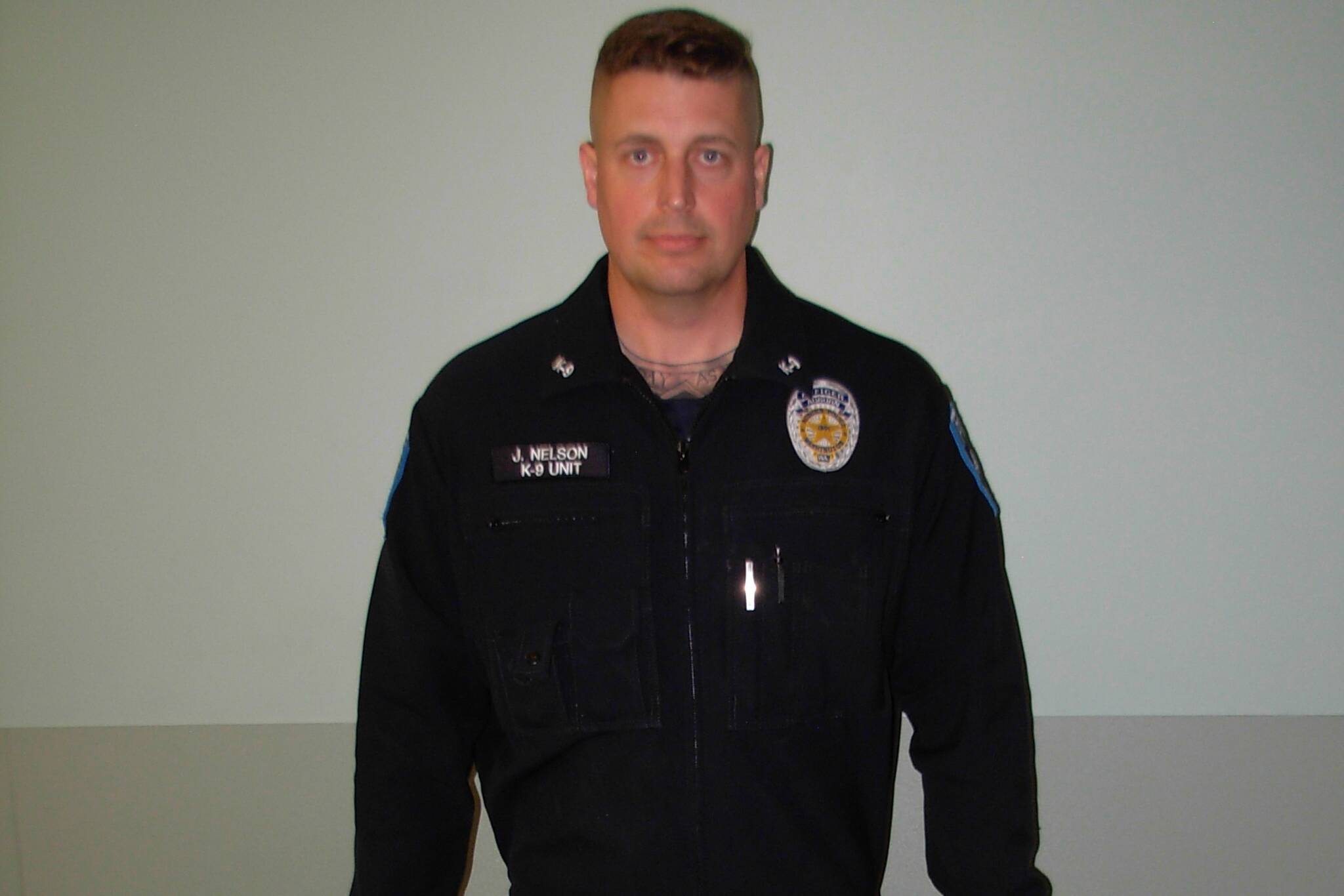(Editor’s note: This story contains profane language.)
Auburn police officer Jeffrey Nelson’s history of violence against members of the Auburn community may be allowed in his trial for the assault and murder of Jesse Sarey in 2019.
During a pretrial hearing on June 29, prosecuting attorney Mark Larson discussed several instances in which Nelson used extreme force against suspects of minor crimes.
Larson argued this was evidence of Nelson’s attitude toward policing and showed a pattern or “plan” that led to the killing of Sarey. The instances show Nelson had a pattern of using extreme violence, including the use of his Taser, chokeholds and letting his K9 named Koen attack people for minor crimes.
Further, Larson said in the cases the prosecution wants to be included as evidence, the people who Nelson assaulted posed little to no threat to the safety of the public or other officers. However, when Nelson wrote reports on his use of force, Larson claims Nelson greatly exaggerated the threat each individual posed in order to justify his extreme use of force.
Larson called to the stand Jon Winterhawk, who was brutalized by Nelson on July 9, 2014, when Winterhawk and his two friends were walking to Winterhawk’s home from a local store. Winterhawk said he and one friend were on the sidewalk and his third friend was walking in the bike lane.
Nelson pulled up on the three men and began questioning them, asking what they were doing, where they were going and other similar questions, Winterhawk recalled. Winterhawk and his friends told Nelson they didn’t want to talk to him, and that Winterhawk said he felt he wasn’t doing anything wrong or illegal by telling Nelson he didn’t want to talk.
Moments later, officer Cristian Adams, who has since been promoted to the rank of commander, pulled his patrol car up to Nelson’s patrol car. Adams’s in-car video camera recorded video and audio of the interaction between the two officers and Winterhawk and his friends.
Larson said neither of the officers knew they were being recorded during their interaction.
Adams and Nelson continue to follow Winterhawk and his friends as the trio crossed the street and walked toward Winterhawk’s house. Winterhawk told the court he remembered telling the officers “have a good night” several times to indicate he didn’t want to engage with the officers and simply wanted to go home.
While the officers followed the three men, they can be heard on the recording shouting obscene and threatening language at them.
“I’ll turn you into a fucking punk if you want to run your mouth,” Adams said to the men, according to the recording.
“Fuck you motherfuckers, look at you run away,” Nelson said, according to the recording.
Winterhawk said that he believed the two officers were trying to get him and his friends to fight the officers, which Winterhawk said they had no intention of doing.
At some point, Nelson asked Adams, “Want to fuck them up?” To which Adams replied: “We might as well.”
Nelson then ordered Winterhawk, who had committed no crime, to get on the ground, before shooting Winterhawk with his Taser. Winterhawk said he remembers falling face down to the ground and hitting his head as the result of getting shocked with the Taser.
After that, Nelson put his knee on Winterhawk’s back and wrapped his arm around Winterhawk’s neck, choking him until he lost consciousness. When he regained consciousness, Winterhawk was in handcuffs.
Larson said that Nelson, who wrote up a report without knowing he had been recorded, greatly exaggerated the threat Winterhawk posed. In his report, Nelson claimed Winterhawk had his fists clenched and was in a “fighting stance,” moments before Nelson used the Taser on him. He also claimed Winterhawk could have had a weapon on him simply because he was wearing baggy clothing.
“When you hear the transcript, and you hear the testimony of Jon Winterhawk, there is no conclusion you can reasonably reach other than the police report was inaccurate,” Larson said. “The question is, is this a manifestation of a scheme or plan of Nelson’s police work for those who disobey him?”
The next case Larson discussed involved Nelson allowing his K9, Koen, to attack a 15-year-old boy who had allegedly been the passenger of a stolen car in May 2018. Several officers had stopped the car, and the three boys fled into the woods next to the road, but two were quickly apprehended.
Eventually, a different Auburn police officer found the 15-year-old boy in the woods and ordered him to get on the ground, and the boy immediately complied and laid on the ground, Larson said.
Nelson’s K9 was off-leash and attacked the child for about 15 seconds, Larson said. In an audio-video recording Larson played for the court, the boy can be heard crying and screaming in agony as Koen rips apart the flesh on the boy’s arms and back.
Eventually, Nelson got his K9 to stop attacking the boy, at which point Nelson can be seen high-fiving the other officers and saying “woohoo,” in an apparent celebration of the dog attack on the child, Larson said.
Shortly after that, Nelson can be heard saying “time to be a big boy and learn to fucking walk,” as the child is still crying out in pain. Larson questioned under what circumstances would it be acceptable for a police officer to celebrate a vicious attack on a child.
Judge Nicole Gaines Phelps said the evidence Larson brought forward was admissible for pretrial purposes only and hasn’t decided whether to allow the evidence in during the actual trial.
Nelson’s defense council followed the state and introduced several pieces of evidence they want to be included during the trial.
The first piece of evidence the defense sought to include was testimony from another Auburn police officer who had previously arrested Jesse Sarey in 2017 at the Muckleshoot Casino. The officer took the stand and said Sarey was non-compliant when asked to leave the casino parking lot and that when the officer attempted to arrest Sarey, he resisted.
After the Auburn police officer took the stand, the defense played recordings of several interviews of people who had witnessed Sarey the night before or the day of his killing.
A common theme throughout the interviews played by the defense was that Sarey seemed to be under the influence of some type of drug and that he was disturbing the public. Some of the witnesses said Sarey was kicking trash cans and throwing the lids around.
Judge Phelps was set to hear arguments from each party regarding the different pieces of evidence on June 30, but the hearing was canceled at the last minute.
Background
In May 2019, Nelson shot and killed Jesse Sarey after attempting to arrest Sarey for jaywalking. Over a year later in 2020, King County Prosecutor Dan Satterberg filed assault and second-degree murder charges against Nelson for the killing of Sarey.
Nelson is the first officer in Washington to be charged with murder since the passage of Initiative 940, which changed the standard for holding police criminally liable for excessive use of force.
Prior to Initiative 940, prosecutors had to prove a police officer acted with evil intent when they killed someone in the line of duty in order to charge that officer with murder — essentially an impossible standard to meet, Satterberg said.
Under Initiative 940, prosecutors now have to prove that a different, reasonable officer would not have used deadly force in the same situation.
Judged by XII Podcast
“Judged by XII” is a Sound Publishing podcast that takes a closer look at Nelson’s murder trial and his role in the death of Jesse Sarey. The most recent episode examines how a judge blocked the release of some photos that show portions of Nelson’s body covered in grim tattoos.








